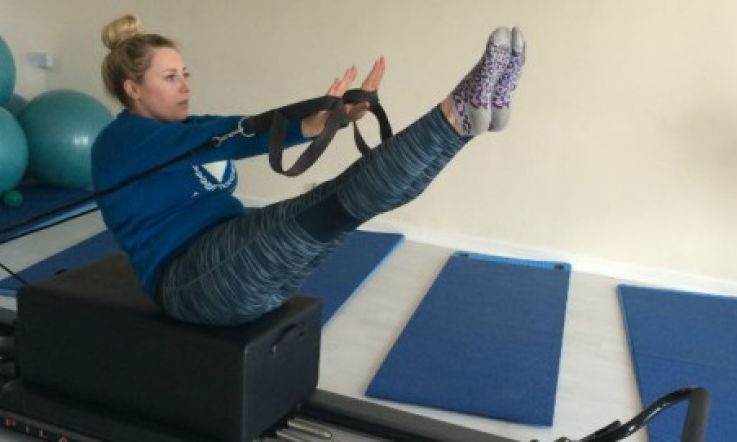Adventure Through Fitness: Week One - The Pilates Reformer

I am about to embark on a fitness journey for the next number of weeks/months which will see me cover all types of exercise in an attempt to figure out simply, which ones cut the mustard and which ones don't.
My instant referral to mustard will already tell you I'm just your average joe who probably indulges in edibles a little too much - with a hectic lifestyle that leaves little room for exercising to work it off. So, an ideal candidate, you say? I do represent a large portion of women out there who simply find it difficult to juggle everything in their everyday lives.
At first I thought grand... how hard can this be? A different work out every week and I get to tell you lot about every detail and make it fun and appealing to the masses. Simple! That is, until I realised how many different types of exercises exist out there.
Take my first choice for example. Pilates. An easy choice I thought... Break yourself in gently I told myself. Then, I called Core Pilates in Raheny and spoke directly to the owner of the studio, Madeleine. "No problem", she said. "Which class are you interested in taking?" Eh... Pilates? That's when I discovered that there are seven different types of Pilates exercises. Yes, seven! Bet you didn't know that either.
So without going into the seven (because you will find out about each and every one in due course) I decided to opt for the reformer. Sounds scary doesn't it? The reformer is an exercise machine which incorporates various Pilates techniques but guarantees you a more challenging, intense workout. Workouts on a Pilates reformer consist of controlled, flowing movements working your muscles through a full range of motions which challenge stability, mobility, endurance, balance and co-ordination.
Advertisement
The reformer is a bed-like frame with a flat platform on it called the carriage, which rolls back and forth on wheels within the frame. The carriage is attached to one end of the reformer by a set of springs which provide choices of different levels of resistance as the carriage is pushed or pulled along the frame. The carriage has shoulder blocks on it that keep you from sliding off the end of the reformer as they push or pull the carriage.
At the spring end of the reformer there is an adjustable bar called a footbar which can be used by the feet or hands as you move the carriage. The reformer also has long straps with handles on them that are attached to the top end of the frame, they can be pulled with legs or arms to move the carriage as well. Body weight and resistance of the springs are what make the carriage more or less difficult to move.
One of the best things about the reformer is its versatility. Exercises can be done lying down, sitting, standing, pulling the straps, pushing the footbar, perched on the footbar, perched on the shoulder blocks, with additional equipment, upside down & sideways. In other words, the reformer can train many parts and dynamics of the body in so many different ways with just one relatively sleek piece of equipment.
Advertisement
The reformer offers all the famous benefits of Pilates including increased muscular endurance, increased core strength, improved posture, increased flexibility and improved breathing. Other equipment and Pilates mat exercises do that too, but the reformer creates a unique and varied exercise environment.
- Some of the benefits explained
The training results of increased muscular endurance include increased muscle fiber endurance, size and strength along with increased connective tissue strength. With increased muscular endurance, your muscles are able to exert force for extended periods of time. Exercising on the reformer requires proper positioning within the core, abdomen and lower back muscles.
By conditioning the core muscles, they will contract with all movements which can stabilise and align your spine. Core strength increases your ability to generate power to your muscles and decreases the risk of injury. Also, with improved alignment your muscles will strengthen to improve spinal support and stability.
Advertisement
Workouts on a reformer require your muscle groups to move through a full range of motion which in turn improves flexibility which decreases strain and stress on your joints and muscles. Pilates workouts also emphasise proper breathing in the sense that breathing becomes deeper and less frequent, resulting in improved relaxation.
The benefits of this include increased lung capacity and breathing efficiency during workouts and at rest. Your lungs are better equipped to supply your body with increased oxygen during workouts.
The instability of a rolling carriage with the springs set at different levels of resistance provides all kinds of stability challenges that develop core strength and promote better balance. For example, having less of the body on the carriage is one of the ways Pilates exercises get harder. It means more body weight has to be supported and the body and machine have to be controlled even more from the core.
When the springs are on a lighter setting some exercises are more challenging for the core because it has to work harder to control and stabilise the movement. The stronger core, the better the balance, posture, and overall well-being.
So there you have it folks, the reformer explained in depth. I found this workout extremely enjoyable and effective and if anything I am more inquisitive as to how all the other Pilates methods work. Stay tuned and follow me on my journey next week where I will be assessing another exercise to give you the low down on.
Have you tried Reformer Pilates before? What do you think? Has it made a difference to your body or your whole, entire life? What exercise plan do you live by?